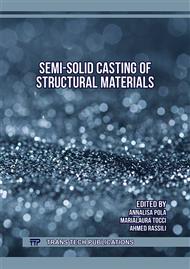p.83
p.91
p.97
p.107
p.115
p.121
p.127
p.135
p.141
Effect of Ingate Length on Microstructure and Properties of Semi-Solid Squeeze Casting CuSn10P1 Alloy
Abstract:
It is easy to occur solid-liquid separation during semi-solid rheological forming, which leads to poor uniformity of microstructure and properties and limits its application in high strength and toughness parts. In this paper, a semi-solid CuSn10P1 alloy slurry was prepared by an enclosed cooling slope channel (for short ECSC). The effect of ingate length on microstructure and properties by semi-solid squeeze casting was studied. The results showed that the proper increase of the length of the ingate is beneficial to improve the uniformity of the microstructure and properties of the semi-solid squeeze casting. The microstructure uniformity and properties are the best when the ingate length is 20mm. The ultimate tensile strength and elongation of semi-solid squeeze casting CuSn10P1 alloy with 20 mm ingate length reached 419.2 MPa and 13.4%.
Info:
Periodical:
Pages:
115-120
Citation:
Online since:
August 2023
Authors:
Keywords:
Price:
Сopyright:
© 2023 Trans Tech Publications Ltd. All Rights Reserved
Share:
Citation:


